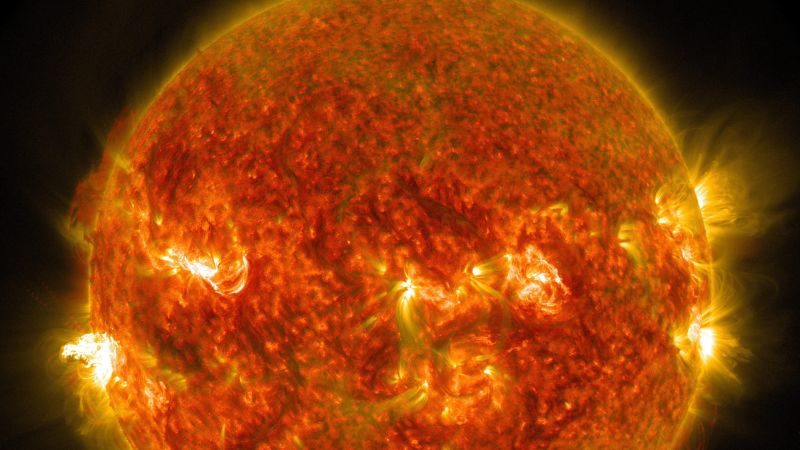
© Solar Dynamics Observatory/ESA/NASAFlares erupting on the Sun in 2014.
An extreme form of solar storm, known as a solar proton event (SPE), struck our planet 2,679 years ago, according to new
research published today in
Proceedings of the National Academy of Sciences. If an event of such magnitude were to happen today, it would likely wreak havoc on our technological infrastructure, including communications and navigation. Lund University geologist Raimund Muscheler and his colleagues presented evidence in the form of elevated levels of beryllium-10 and chlorine-36 isotopes embedded within ancient Greenland ice cores.
It's now the third massive SPE known to scientists, the others occurring 1,245 and 1,025 years ago. This latest discovery means solar storms of this variety are likely happening more frequently than we thought-perhaps once every 1,000 years-but more data is required to create more reliable estimates.
SPEs happen in the wake of a massive solar flare or coronal mass ejection on the Sun. These stellar events send streams of particles, including high-energy protons, toward Earth, where they interact with the Earth's atmosphere, triggering reactions that increase the rate of radionuclide production, including carbon-14, beryllium-10, and chlorine-36 (radionuclides are unstable atoms with excess nuclear energy). Traditionally, SPEs have been detected as spikes of carbon-14 in tree rings, but they can also be spotted as spikes of beryllium-10 and chlorine-36 in ancient ice cores. The authors of the new study said scientists tend to overemphasize carbon-14 at the expense of searching for other markers, and that "efforts to find [SPEs] based solely on [carbon-14] data likely lead to an underestimated number of such potentially devastating events for our society."
SPEs are capable of temporarily degrading the Earth's ozone layer, which allows excessive amounts of ultraviolet radiation to reach the ground. This is (moderately) bad for lifeforms on the surface, but it's not the kind of thing that could trigger a mass extinction. As a risk, SPEs are a much bigger problem in terms of how they would affect our technologies; a sufficiently strong SPE poses "a threat to modern society in terms of communication and navigation systems, space technologies, and commercial aircraft operations," according to the new study. These extreme space weather events could also be catastrophic for astronauts working in the International Space Station, who aren't shielded by Earth's atmosphere.
Importantly, SPEs are not to be confused with
geomagnetic storms, which are a related, but distinct, phenomenon.
SPEs have been detected before, including events in
Quebec (1989) and
Sweden (2003) but the the newly discovered storm appears to have been stronger than anything seen with our modern instruments over the past 70 years. Indeed, we now have the tools to detect these events as they happen. For the new study, Muscheler and his colleagues analyzed two Greenland ice cores, finding spikes of both beryllium-10 and chlorine-36 in ice dated at 2,679 years old-evidence consistent with an SPE.
"We think that we could exclude other suggested hypotheses for such increases, such as supernova explosions or gamma ray bursts," Muscheler told Gizmodo. The team also found increased values of carbon-14 in trees rings that correspond to the 660 BCE event, which "is to our knowledge only consistent with the effects of a solar proton event," he said.
So that's three extreme PCEs in the past 2,700 years (that we know of)-an observation consistent with an occurrence rate of one every 1,000 years. But while this inference is a tempting one to make, Muscheler said we need to be careful about jumping to conclusions owing to a dearth of data.
"I think the statistical bases for occurrence rate estimates is very weak," he said. "We now have three of such events-660 BCE, 775 AD and a slightly weaker one at 993 AD-but to say that these occur on average every 1,000 years would be very speculative. We will need more high-resolution carbon-14, beryllium-10, and chlorine-36 data to get this occurrence rate more robustly." To which he added: "We have only a very short window into the Sun's behavior by our observations and measurements over the last 70 years," but as the new research makes clear, "the Sun can produce much more powerful events-this has to be included in today's risk analyses."
No doubt, more examples of similar events in Earth's history would be helpful. To that end, Muscheler is in Bern, Switzerland right now trying to acquire new high-resolution samples for this very purpose. Until more is known, however, it's best to prepare, creating technologies and systems capable of withstanding these extreme-yet disturbingly frequent-stellar events.
Reference: Proceedings of the National Academy of Sciences
Reader Comments
[Link]
There is the missing years, the Dark Ages of Greece where the mythical Jason sailed. Europe had a solid base in copper mining which disappeared wholly to be replaced by inferior workings.
The evidence is there.